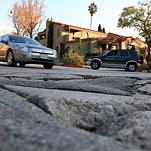MINOT, N.D. — There are four seasons up here, the joke goes: winter, winter, winter and construction.
In North Dakota, After the Water, the Winter

Months after the flooding of Minot, N.D., residents are still coping with salvage and recovery.
By A. G. SULZBERGER
Published: November 8, 2011
Related
-
They Dropped Their Flood Insurance, Then the ‘Mouse’ Roared (June 24, 2011)
-
Even Boom States Get the Blues (June 27, 2011)
Connect With Us on Twitter
Follow @NYTNational for breaking news and headlines.
Nicole Bengiveno/The New York Times
Brian Troxel cracked open the mud-caked sliding door in his living room.

And as the displaced residents of this city, soaked by floodwaters for much of the summer, were made fully aware this week with the arrival of the first snowflakes, construction season is ending.
For Andrew Deck, a retiree temporarily living in a camper, that means continuing his frenetic push to restore his home to livable condition in time, he said, to get a Thanksgiving turkey into the oven.
Even as some of his neighbors on the valley floor, worried about another assault by the Souris River, have moved more warily — or not at all — Mr. Deck has poured tens of thousands of dollars into his longtime home. He stayed after a flood in the late 1960s and he is staying put once again, this time buying flood insurance and putting up a yellow lawn sign declaring, “I’m coming back.”
But if the river rises again next year, as many here fear, he will admit defeat, he said. “I’m not going to go through it again,” he said. “If something happens next year, I’m going to take the money and leave.”
Across the Midwest, residents of flooded communities have been wrestling with the same decision of whether to return or retreat from the rivers that have asserted their domain over the homes along their banks. But here in Minot (pronounced MY-not), where more than a quarter of the population was displaced, the question of risk has been complicated by distinctly local factors.
This city of about 41,000, located in an oil-rich area of the state, was already dealing with a housing crunch that has filled virtually every house, apartment and motel room in the region. Adding urgency, the flood arrived unusually late in the year, giving little time to rebuild or relocate before the fierce North Dakota winter.
“They’re running out of time,” said Curt Zimbelman, the mayor. “The weather’s going to change.”
A recent survey of displaced residents found that fewer than 10 percent of the 4,100 flooded homes were currently occupied, though that number was expected to rise to 18 percent by winter. Most of the rest of the people surveyed indicated that they would stay in trailers provided by the Federal Emergency Management Agency, with family or friends, or in new residences, or move out of town.
But the race to secure accommodations before temperatures drop has meant that many residents moved forward without important information. A number of people who are already rebuilding now know that their homes lie in the path of a proposed levee, under a preliminary flood control plan unveiled last week.
Bob Miller, a member of the City Council who had just started to reinsulate his gutted home, is among those planning to fight to change the design during public hearings this week. “I did not see that coming,” he said. “I did not think I was that close.”
But Mr. Miller, like others in low-lying neighborhoods that provided much of the lower-income housing, said the new information would not change his plans to return by the end of the year.
The reason is that housing is hard to find and harder to afford, particularly given that few people had flood insurance. The price of an average home, driven largely by the influx of workers for the oil fields, has increased to $190,000 from $130,000 over the last five years, with an additional spike since the flood, according to real estate agents.
Meanwhile, the signs of progress in the worst-hit neighborhoods are uneven. Some houses have been fixed, others were just gutted to prevent decay, and still others stand untouched, abandoned and full of the muck of a month underwater. Contractors working here warned that those left unprotected could suffer serious damage.
But the homeowners have their reasons for the varying responses. Some are fearful of the river and others are determined not to be cowed by it. One common sentiment, echoing the complaints in flooded communities along the Mississippi and Missouri Rivers, is that this disaster was not the result of too much water but of mismanagement of upstream dams — a notion those in charge of controlling water flow vigorously dispute.
“Someone will make sure this doesn’t happen again,” said George Killmer, as he discussed renovation plans with his contractor outside his home.
Sonja Neubauer, now living in a trailer park, was more cautious. “If someone gave me a house down there I wouldn’t take it,” she said. “It might be worse next year.”
Amy Moen, head of the planning commission in Minot, said the city would need to protect the interests of homeowners who might overlook the risks of returning. “I never thought in my lifetime I’d see it flood,” she said. “But it only takes one time to prove it can happen.”
More than a third of the valley residents are planning to endure the winter in FEMA trailers, despite fears that structures more commonly used to house victims of hurricanes in the South will not be able to handle the subzero temperatures at the northern border. Many of the trailers have yet to arrive.
Brian Troxel and his family live in a trailer next to the shell of their large house, where a tricycle deposited by the river hung from the roof. The trailer had no storm door to hold back the wind and snow and the walls, he suspected, were so thin they might layer with frost. He never worried about the river before this year but he always knew to take winter seriously.
“We know what North Dakota winters are like,” Mr. Troxel said. “There is no way this will be problem free.”














